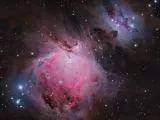- Details
- More images
Products description
Experience TS Photon 6“ Newton and ZWO ASI 120MC-S and Canon EOS 1000Da camera
Since I bought a DSLR (Canon EOS 1000Da - also on Mr. Kloß's recommendation) for astrophotography shortly before the NEQ5 arrived in March 2020, it was only a matter of time before, after the first steps with various lenses, a telescope came in front of the camera. In May 2020, my inventory was supplemented by a TS Photon 6" f/5 Newtonian, and shortly thereafter by a camera from ZWO, an ASI 120MC-S, for guiding and photographing the sun, moon, and planets.Because the Newtonian was a gift, I can't comment on the advice I received from the telescope specialists. Nevertheless, I assume the advice was good, as the Newtonian is a simple and useful telescope, making it perfect for a beginner in astrophotography.
Autoguiding is highly recommended for astrophotography, especially with longer focal lengths. Therefore, the components for automatic tracking were purchased very quickly after the Newtonian arrived. Here, too, I received excellent advice from Mr. Kloß, as the prerequisite for the autoguiding camera was that it should be usable for multiple purposes and also be affordable. At that time, I was still just beginning to get into astrophotography, which is generally known as a cost-intensive hobby. Therefore, you don't want to invest too much money in the beginning. Take it in hand, especially if you're not sure whether you'll enjoy this hobby. The choice quickly fell on the ZWO ASI120MC-S mentioned above.
Shown: TS Photon on NEQ5, ZWO ASI120MC-S on TS Deluxe guide scope
Now the first results were visible, which I don't want to withhold, as they actually beautifully document the first steps in astrophotography.
The first object I used was M13, as it's relatively easy to find even in the city sky. This photo was taken without autoguiding, a coma corrector, and only with a 1.25" T2 adapter that came with a set of eyepieces. Since this photo was taken a long time ago, I can't reconstruct the details 100%, but I'll try. Darks, bias, and 245 lights of 10 seconds each were used, resulting in a total exposure time of approximately 40 minutes.
Many lessons in technology, software, and object detection followed. These included images of M31 (45x180s) and M42 (60x180s), among others, thanks to autoguiding with considerably longer exposure times for each frame. The 1.25" T2 adapter was also replaced with a 2" one.
This Product was added to our catalogue on 03/05/2023.
Categories
Quick purchase
Welcome back!
Last viewed:
Manufacturer
Shipping country





